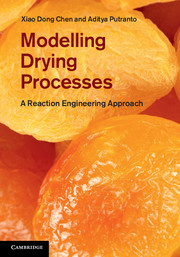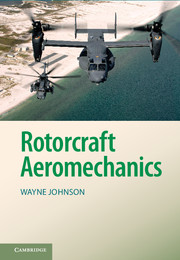Refine search
Actions for selected content:
5487 results in Thermal-fluids engineering

Modelling Drying Processes
- A Reaction Engineering Approach
-
- Published online:
- 05 May 2013
- Print publication:
- 23 May 2013

Rotorcraft Aeromechanics
-
- Published online:
- 05 May 2013
- Print publication:
- 29 April 2013
7 - Performance
-
- Book:
- Rotorcraft Aeromechanics
- Published online:
- 05 May 2013
- Print publication:
- 29 April 2013, pp 243-270
-
- Chapter
- Export citation
19 - Flap Motion
-
- Book:
- Rotorcraft Aeromechanics
- Published online:
- 05 May 2013
- Print publication:
- 29 April 2013, pp 749-787
-
- Chapter
- Export citation
Contents
-
- Book:
- Rotorcraft Aeromechanics
- Published online:
- 05 May 2013
- Print publication:
- 29 April 2013, pp vii-xvi
-
- Chapter
- Export citation
17 - Beam Theory
-
- Book:
- Rotorcraft Aeromechanics
- Published online:
- 05 May 2013
- Print publication:
- 29 April 2013, pp 671-709
-
- Chapter
- Export citation
8 - Design
-
- Book:
- Rotorcraft Aeromechanics
- Published online:
- 05 May 2013
- Print publication:
- 29 April 2013, pp 271-302
-
- Chapter
- Export citation
3 - Hover
-
- Book:
- Rotorcraft Aeromechanics
- Published online:
- 05 May 2013
- Print publication:
- 29 April 2013, pp 39-91
-
- Chapter
- Export citation
4 - Vertical Flight
-
- Book:
- Rotorcraft Aeromechanics
- Published online:
- 05 May 2013
- Print publication:
- 29 April 2013, pp 92-122
-
- Chapter
- Export citation
Frontmatter
-
- Book:
- Rotorcraft Aeromechanics
- Published online:
- 05 May 2013
- Print publication:
- 29 April 2013, pp i-vi
-
- Chapter
- Export citation
5 - Forward Flight Wake
-
- Book:
- Rotorcraft Aeromechanics
- Published online:
- 05 May 2013
- Print publication:
- 29 April 2013, pp 123-151
-
- Chapter
- Export citation
21 - Flight Dynamics
-
- Book:
- Rotorcraft Aeromechanics
- Published online:
- 05 May 2013
- Print publication:
- 29 April 2013, pp 844-914
-
- Chapter
- Export citation
1 - Introduction
-
- Book:
- Rotorcraft Aeromechanics
- Published online:
- 05 May 2013
- Print publication:
- 29 April 2013, pp 1-26
-
- Chapter
- Export citation
11 - Actuator Disk
-
- Book:
- Rotorcraft Aeromechanics
- Published online:
- 05 May 2013
- Print publication:
- 29 April 2013, pp 414-441
-
- Chapter
- Export citation
10 - Unsteady Aerodynamics
-
- Book:
- Rotorcraft Aeromechanics
- Published online:
- 05 May 2013
- Print publication:
- 29 April 2013, pp 366-413
-
- Chapter
- Export citation
12 - Stall
-
- Book:
- Rotorcraft Aeromechanics
- Published online:
- 05 May 2013
- Print publication:
- 29 April 2013, pp 442-461
-
- Chapter
- Export citation
9 - Wings and Wakes
-
- Book:
- Rotorcraft Aeromechanics
- Published online:
- 05 May 2013
- Print publication:
- 29 April 2013, pp 303-365
-
- Chapter
- Export citation
22 - Comprehensive Analysis
-
- Book:
- Rotorcraft Aeromechanics
- Published online:
- 05 May 2013
- Print publication:
- 29 April 2013, pp 915-920
-
- Chapter
- Export citation
18 - Dynamics
-
- Book:
- Rotorcraft Aeromechanics
- Published online:
- 05 May 2013
- Print publication:
- 29 April 2013, pp 710-748
-
- Chapter
- Export citation
16 - Blade Motion
-
- Book:
- Rotorcraft Aeromechanics
- Published online:
- 05 May 2013
- Print publication:
- 29 April 2013, pp 582-670
-
- Chapter
- Export citation
